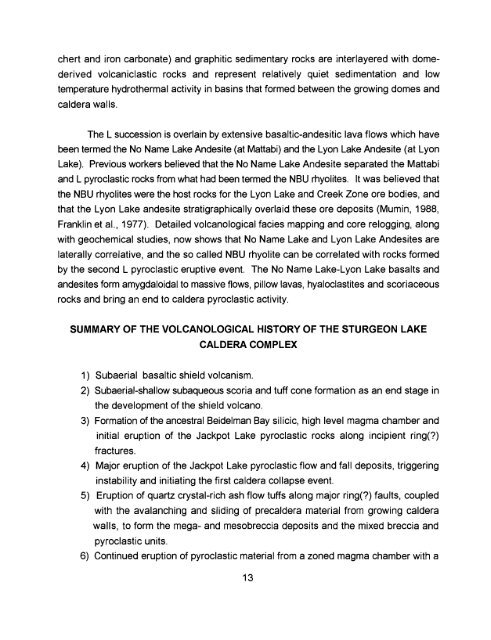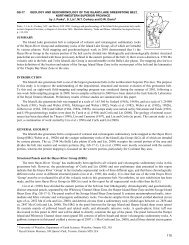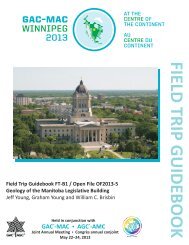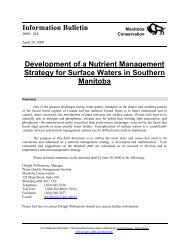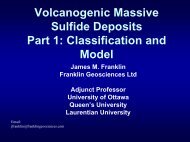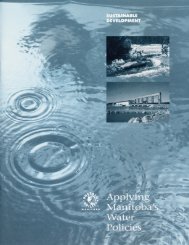Physical Volcanology, Hydrothermal Alteration and Massive ...
Physical Volcanology, Hydrothermal Alteration and Massive ...
Physical Volcanology, Hydrothermal Alteration and Massive ...
Create successful ePaper yourself
Turn your PDF publications into a flip-book with our unique Google optimized e-Paper software.
chert <strong>and</strong> iron carbonate) <strong>and</strong> graphitic sedimentary rocks are interlayered with domederivedvolcaniclastic rocks <strong>and</strong> represent relatively quiet sedimentation <strong>and</strong> lowtemperature hydrothermal activity in basins that formed between the growing domes <strong>and</strong>caldera walls.The L succession is overlain by extensive basaltic-<strong>and</strong>esitic lava flows which havebeen termed the No Name Lake Andesite (at Mattabi) <strong>and</strong> the Lyon Lake Andesite (at LyonLake). Previous workers believed that the No Name Lake Andesite separated the Mattabi<strong>and</strong> L pyroclastic rocks from what had been termed the NBU rhyolites. It was believed thatthe NBU rhyolites were the host rocks for the Lyon Lake <strong>and</strong> Creek Zone ore bodies, <strong>and</strong>that the Lyon Lake <strong>and</strong>esite stratigraphically overlaid these ore deposits (Mumin, 1988,Franklin et aI., 1977). Detailed volcanological facies mapping <strong>and</strong> core relogging, alongwith geochemical studies, now shows that No Name Lake <strong>and</strong> Lyon Lake Andesites arelaterally correlative, <strong>and</strong> the so called NBU rhyolite can be correlated with rocks formedby the second L pyroclastic eruptive event. The No Name Lake-Lyon Lake basalts <strong>and</strong><strong>and</strong>esites form amygdaloidal to massive flows, pillow lavas, hyaloclastites <strong>and</strong> scoriaceousrocks <strong>and</strong> bring an end to caldera pyroclastic activity.SUMMARY OF THE VOLCANOLOGICAL HISTORY OF THE STURGEON LAKECALDERA COMPLEX1) Subaerial basaltic shield volcanism.2) Subaerial-shallow subaqueous scoria <strong>and</strong> tuff cone formation as an end stage inthe development of the shield volcano.3) Formation of the ancestral Beidelman Bay silicic, high level magma chamber <strong>and</strong>initial eruption of the Jackpot Lake pyroclastic rocks along incipient ring(?)fractures.4) Major eruption of the Jackpot Lake pyroclastic flow <strong>and</strong> fall deposits, triggeringinstability <strong>and</strong> initiating the first caldera collapse event.5) Eruption of quartz crystal-rich ash flow tuffs along major ring(?) faults, coupledwith the avalancl"ling <strong>and</strong> sliding of precaldera material from growing calderawalls, to form the mega- <strong>and</strong> mesobreccia deposits <strong>and</strong> the mixed breccia <strong>and</strong>pyroclastic units.6) Continued eruption of pyroclastic material from a zoned magma chamber with a13


